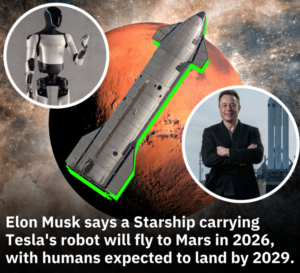Elon Musk has never been one to shy away from ambitious goals, but his latest announcement has left the world in awe. SpaceX’s Starship—humanity’s most powerful rocket—will launch towards Mars in late 2026, and it won’t be traveling alone. Joining the mission will be none other than Tesla’s humanoid robot, Optimus.
Musk took to X (formerly Twitter) to share the groundbreaking news, suggesting that if everything goes according to plan, humans could set foot on Mars as early as 2029—though 2031 remains a more practical target. The sheer scale, technology, and vision behind this mission could redefine the future of space exploration, AI, and human existence itself.
Here’s a closer look at what makes this mission so revolutionary—and why it could change everything we know about life beyond Earth.
🚀 Starship: The Titan That Will Take Us to Mars
Standing at 123 meters (403 feet), Starship is officially the largest and most powerful rocket ever built. Designed for full reusability, this rocket is SpaceX’s ultimate weapon for deep space travel.
🔹 Why Starship Is a Game-Changer
✅ Fully Reusable – Unlike previous rockets, Starship is designed to land and be reused, dramatically reducing costs.
✅ Massive Payload Capacity – It can carry over 100 tons of cargo—or up to 100 passengers—per trip.
✅ Built for Mars – Equipped with heat shields and solar-powered systems, it’s designed to land, refuel, and eventually return to Earth.
Starship is not just another rocket—it’s Musk’s interplanetary dream coming to life. And now, that dream is about to take its first real step toward Mars.
🤖 Optimus: Tesla’s Humanoid Robot Is Going to Space!
In what may be one of the most unexpected twists in space exploration, Musk also revealed that Tesla’s humanoid robot, Optimus, will be part of the 2026 Mars mission.
💰 Price Tag: Between $20,000 and $30,000
🛠 Purpose: Initially designed for Earth, now being adapted for Mars exploration
🔹 What Will Optimus Do on Mars?
🔧 Assist with setup – Building the first Martian base will require intensive labor, and Optimus could be the first worker on the Red Planet.
👨🚀 Reduce risk for humans – Before astronauts arrive, robots can test conditions, build shelters, and even grow food.
🚜 Terraforming aid – Over time, Optimus could help prepare the Martian landscape for future colonization.
The idea of humanoid robots working on Mars before humans even arrive sounds like something straight out of a sci-fi movie—but with Musk at the helm, it’s becoming reality.
🌎 What This Means for Humanity
If Musk succeeds in launching Starship in 2026 and sending humans to Mars by 2029, this will be the greatest achievement in human history.
But beyond that, it will open doors to things we once thought impossible:
🌍 A second home for humanity – Mars could become a backup planet for Earth.
🤖 AI-driven colonization – Optimus and other robots could pave the way for human settlers.
🚀 New industries beyond Earth – From space tourism to off-world mining, Mars could revolutionize the economy.
Musk has long said that humanity must become a multi-planetary species to survive in the long run. Now, that vision is closer than ever.
🌌 The Road Ahead: Can Musk Really Pull This Off?
Skeptics argue that Musk’s timeline is too aggressive, pointing to the delays SpaceX has faced with previous missions. Others question whether we have the technology to support human life on Mars yet.
🚧 Challenges Musk Must Overcome
❌ Radiation Exposure – Can we safely protect astronauts from cosmic radiation?
❌ Sustaining Human Life – Growing food, producing water, and creating shelter are massive obstacles.
❌ Return Missions – Getting to Mars is one thing; getting back is another.
Despite these challenges, Musk has defied the odds before. Falcon 9, Dragon, and Starship itself were once considered impossible—but today, they are real, functioning technologies.
If anyone can make this happen, it’s Elon Musk.
🌠 Are We Ready for a Mars Future?
The thought of robots working on Mars and humans following just a few years later is both thrilling and terrifying.
👨🚀 Would YOU take a one-way trip to Mars?
🤖 Do you think AI should lead the way in space colonization?
💬 Drop your thoughts in the comments below!
One thing is clear: we are living in the most exciting time in human history.
And the future?
🚀 It’s already on its way to Mars.





